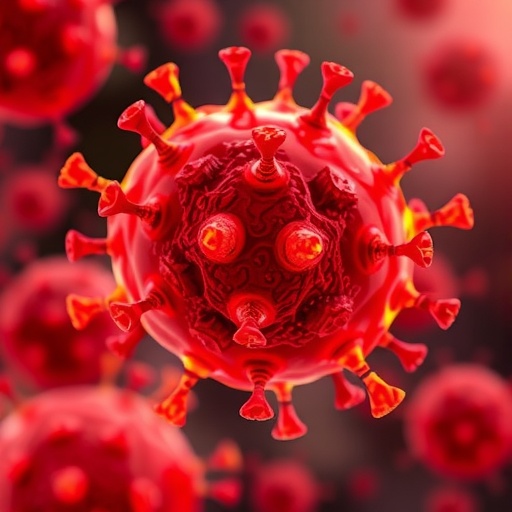.adsslot_7Q8fFxEwI9{ width:728px !important; height:90px !important; }
@media (max-width:1199px) { .adsslot_7Q8fFxEwI9{ width:468px !important; height:60px !important; } }
@media (max-width:767px) { .adsslot_7Q8fFxEwI9{ width:320px !important; height:50px !important; } }
ADVERTISEMENT
Pathophysiological assessments in infected mice revealed that the bovine H5N1 strain induces a more aggressive neuroinflammatory response, characterized by microglial activation, astrocyte proliferation, and extensive neuronal apoptosis compared to the Vietnam isolate. Immunohistochemical staining for markers such as Iba-1 and GFAP illustrated this intensified glial response, while TUNEL assays validated the widespread neuronal death. These cellular events culminate in pronounced neurological impairment, reflected in progressive motor deficits and heightened mortality rates observed in mice inoculated with the bovine virus.
Intriguingly, transcriptomic profiling of infected brain tissues uncovered distinct host gene expression signatures in response to the two viral variants. The bovine H5N1 infection triggered robust upregulation of inflammatory cytokines including TNF-α, IL-6, and IFN-β, potentially amplifying immunopathology. Additionally, genes implicated in antigen presentation, apoptosis, and blood-brain barrier permeability showed differential expression, suggesting that viral factors selectively manipulate host neuroimmune pathways to facilitate infection and persistence. This molecular interplay between virus and host provides valuable targets for therapeutic intervention aimed at mitigating neurovirulence.
The enhanced neurotropism documented in this study raises urgent questions regarding the zoonotic threat posed by bovine-adapted H5N1 viruses. Although cattle are not commonly considered primary reservoirs for influenza viruses, their role as intermediate hosts could facilitate viral evolution and potentially create variants with heightened pathogenicity in humans. The neurovirulent phenotype demonstrated in mice suggests the necessity for vigilant surveillance of influenza infections in non-traditional hosts, alongside refinement of public health strategies to monitor and mitigate emergent neurotropic influenza strains.
Beyond its implications for influenza virology, this work enriches the broader field of neuroinfectious diseases by exemplifying how viral adaptations extend pathogenic potential beyond classical respiratory tropism. The study accentuates the complexity of viral-host dynamics within the CNS, where barriers to infection are multifaceted and immune responses uniquely nuanced. Understanding the molecular underpinnings that dictate neurotropism not only informs influenza management but also improves our grasp of viral neuropathogenesis across diverse viral families.
The utilization of the C57BL/6J murine model proved indispensable, offering a well-characterized immunological background to dissect viral behavior and host responses. However, the authors acknowledge limitations inherent in the mouse model, including species-specific differences in receptor distribution and immune regulation that may not fully recapitulate human CNS infection. Future studies incorporating additional animal models, including those with closer physiological relevance to humans, as well as human neuronal cell cultures, are crucial for validating these findings and translating them into clinical context.
From a therapeutic standpoint, the heightened neurovirulence exhibited by the bovine-adapted H5N1 signals a pressing need to explore antiviral agents that can penetrate the CNS effectively and counter neuroinflammation. Current influenza treatments predominantly target respiratory infection sites; thus, the emergence of neurotropic strains mandates expansion of pharmacological strategies to encompass neuroprotective and immunomodulatory modalities. The elucidation of viral-host molecular interactions provided by this study could guide the design of novel therapeutics aimed at blocking viral entry into neuronal cells or dampening deleterious host immune responses.
The broader epidemiological implications are equally profound. The interface between domestic animals, wildlife, and humans represents a dynamic ecosystem facilitating viral reassortment and mutation. This research highlights the importance of comprehensive One Health approaches, integrating veterinary surveillance with human health monitoring to preempt rapid viral adaptations that might spark outbreaks of neurotropic influenza. Heightened awareness and interdisciplinary collaboration are imperative to curtail the risk posed by increasingly neurovirulent influenza viruses crossing species barriers.
In summary, the research conducted by Goldin, van Tol, Johnson, and colleagues marks a pivotal advance in our understanding of H5N1 virus biology. By demonstrating that a bovine-adapted H5N1 variant exhibits enhanced neurotropism relative to a classical human-derived Vietnam isolate, the study draws attention to subtle viral adaptations with profound pathological consequences. The integration of virological, immunological, and neuropathological analyses provides a comprehensive framework that informs both basic science and clinical strategies to confront evolving influenza threats. This work decisively illustrates that influenza virus-host interactions are far more intricate than previously appreciated, especially within the neural milieu.
As influenza viruses continue to evolve unpredictably, dissecting the molecular determinants enabling neuroinvasion and pathogenicity remains an urgent research frontier. The bovine H5N1 findings serve as both a warning and an opportunity—spotlighting the adaptive capacity of influenza viruses while identifying novel avenues for intervention. Continued exploration of neurotropic influenza variants will enrich our collective preparedness, ensuring that emergent viral threats can be detected early, understood in depth, and ultimately neutralized before causing widespread neurological disease.
Subject of Research:
The study investigates the enhanced neurotropism of a bovine-adapted H5N1 influenza virus compared to a Vietnam H5N1 isolate, focusing on viral replication, neuroinvasion, and resultant neuropathology in C57BL/6J mice.
Article Title:
Enhanced neurotropism of bovine H5N1 compared to the Vietnam H5N1 isolate in C57BL/6J mice
Article References:
Goldin, K., van Tol, S., Johnson, R.C. et al. Enhanced neurotropism of bovine H5N1 compared to the Vietnam H5N1 isolate in C57BL/6J mice. npj Viruses 3, 43 (2025). https://doi.org/10.1038/s44298-025-00121-0
Image Credits: AI Generated
Tags: avian influenza virus adaptationsBovine H5N1 neurotropismcentral nervous system infectionH5N1 pathogenesis insightshigh pathogenicity avian influenzainfluenza virus-host interactionsmurine model C57BL/6Jneuroinvasion mechanismsneurological disease in cattleVietnam H5N1 isolate comparisonviral replication kineticszoonotic influenza research





